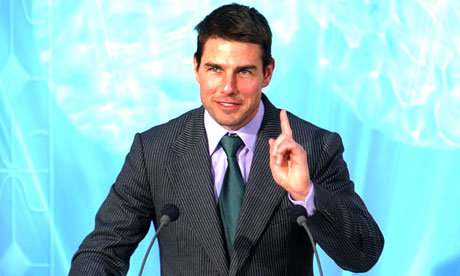
In its vetting of new members, the Church of Scientology once demanded not only the confession of misdemeanours in the current lifetime, but interrogated "the individual's subversive activities along the great time track going through myriad past lives". Among the questions asked were: "Have you ever enslaved a population?"; "Did you come to Earth for evil purposes?"; "Have you ever eaten a human body?"; "Have you ever zapped anyone?" It's easy to see why Hari Kunzru – in his Pynchonesque novel Gods Without Men – is the latest in a procession of authors to use the bizarre world of 20th-century cults as a setting for fiction. Rather more difficult is performing the kind of academic and anthropological inquiry into Scientology that Hugh Urban attempts in The Church of Scientology.
Urban's book is self-consciously scholarly and dry, weighed down by its wealth of footnotes and repeated references to Bourdieu, Simmel and Lévi-Strauss. Maintaining such learned disdain in the face of some seriously juicy material is clearly something of a strain. Urban draws readers' attention to the fact that his work "could probably serve as the basis for a spy novel or a thriller film" or that "the history of Scientology's quest for tax-exempt status is surely worthy of a book or even a detective novel of its own". He gives the impression that, having set out to write this scrupulously recondite account, he wishes for nothing more than to redraft it as a new Da Vinci Code.
Another problem for Urban is Scientology's ruthless pursuit of its detractors. In 1976, under the codename Operation Freakout, Scientologists allegedly carried out an orchestrated attack on a critical journalist, Paulette Cooper, aimed at getting her "incarcerated in a mental institution or jail". Since then, Scientology has gone after its enemies aggressively, using its vast wealth and army of lawyers to suppress the stories of disaffected former members and investigative journalists. Urban's portrayal of the workings of the cult is insistently measured, following what he terms – in a phrase as ugly as it is clumsy – a "hermeneutics of respect and a hermeneutics of suspicion". There are repeated references to "unexplored rabbit-holes" of narrative, blocked up for fear of antagonising Scientology's paranoid information police. This nervousness means that Urban's book has a strangely neutered feel, often passing off to other authors the job of interpreting the seamier sides of the religion.
The anxiety also has a formal effect, with Urban's style, already reeking of the lecture hall, muddied by hedging and equivocation. Nothing is firmly stated; everything is "arguable", "possible", "perhaps". The book sweats from fear of litigation.
These grumblings aside, The Church of Scientology is a fascinating book. Indeed, it may be the case that the arid prose and timid approach are the price we have to pay for the deep and often brilliant anthropological dissection that Urban carries out. Where more populist authors might find it difficult, for instance, to take seriously a religion that makes its most devoted followers sign a "billion-year contract", Urban is po-faced throughout. As a result, he is granted exceptional access to Scientologists and their detractors, and builds from the often barmy material a compelling picture of the birth of a new religion. For this is the book's central thesis: that by analysing how new religions emerge and flourish, we may better understand those whose origins are lost in the haze of time.
Urban's conclusion is unappetising. Scientology's development from L Ron Hubbard's cod-psychoanalysis Dianetics in the 1950s to a bona fide religion given tax-exempt status by the IRS in the 1990s seems to have been driven almost exclusively by profit. In a 1972 policy letter circulated to senior Scientologists, Hubbard makes this explicit: "Make money… make more money… make other people produce so as to make money." The structure of the religion, with its relentless teleology and gradually revealed esoterica, appears to be designed principally as a way of extracting cash from its followers, with the cost of attaining the upper reaches of Operating Thetan status (don't ask) running into hundreds of thousands of dollars.
But to dismiss Scientology as mere spiritual snake oil is too easy. There is clearly something about Hubbard's syncretic bricolage of cold war paranoia, new age spiritualism and sci-fi pulp fiction that continues to convince its followers in ways that traditional religions cannot.
Urban persuasively suggests that it was Hubbard's talent as an author that enabled him to create a religious narrative that spoke to the age of the nuclear bomb and space exploration and Wall Street. Hubbard's novels are not in the league of his peers Philip K Dick or Robert Heinlein, but he was a major contributor to the golden age of pulp fiction, averaging between 70,000 and 100,000 words a month, and his best book – Final Blackout – is a fine example of the genre. Scientology is what happens when the novelist's role as God of his created worlds spills over into everyday life. Hubbard realised that he could control real people, particularly Hollywood actors used to assuming fictitious roles, as he controlled the characters in his books. If we buy Urban's argument, then religions are formed out of the same creative ordering of the world as literature.
Despite the infelicitous prose and a certain mildness in the face of the worst excesses of the cult, Urban's portrayal of the birth and boom of Scientology is absorbing and impressive. That he managed to write it without incurring either lawsuits or a dagger in the back is more remarkable still.
Alex Preston is the author of This Bleeding City (Faber).

